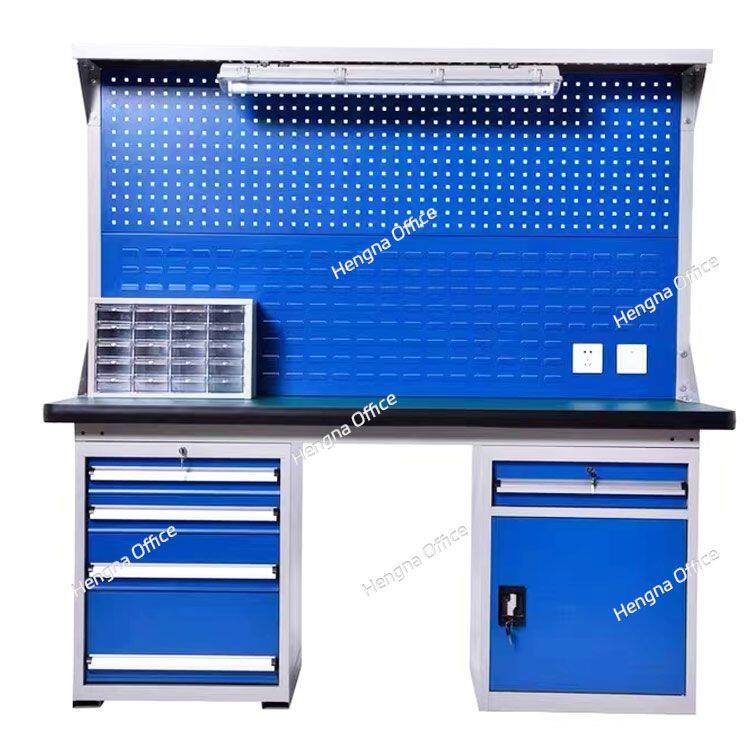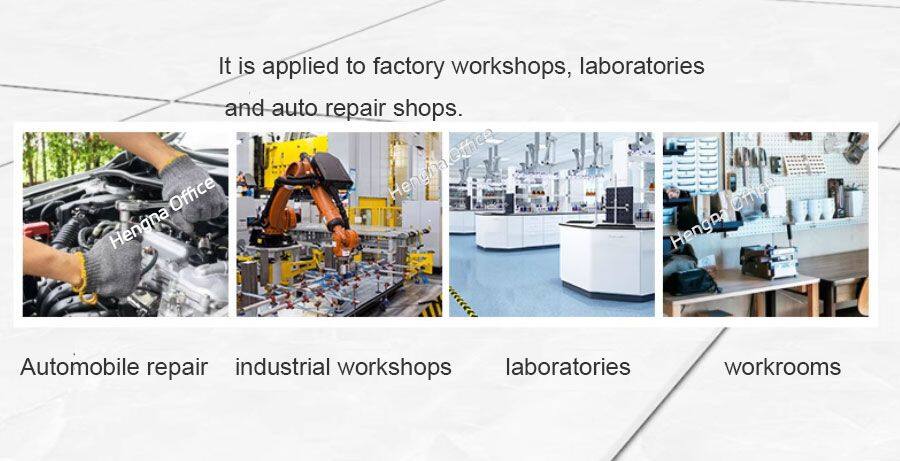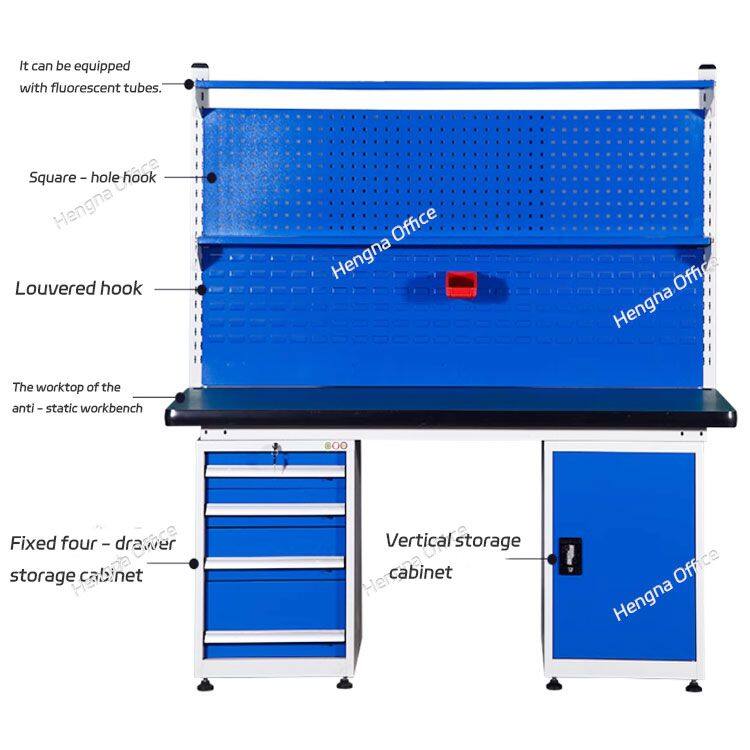-
 Sarah
Hi there! Welcome to my shop. Let me know if you have any questions.
Sarah
Hi there! Welcome to my shop. Let me know if you have any questions.
Your message has exceeded the limit.

ESD-Safe Heavy Workbenches: Essential for Electronics Repair Work
2025-11-03 13:47:16
Electronics repair and assembly operations demand specialized workbenches that protect sensitive components from electrostatic discharge while providing durable, functional workspaces. ESD-safe heavy workbenches serve as critical infrastructure in electronics repair shops, manufacturing facilities, and service centers where static electricity can damage valuable components and compromise product quality. This comprehensive guide explores the essential features and considerations for selecting ESD-safe workbenches specifically designed for electronics applications.
Understanding ESD Protection Requirements
Electrostatic discharge represents one of the most significant threats to electronic components, with static charges as low as 100 volts capable of damaging sensitive semiconductors and integrated circuits. Electronics workbenches must provide comprehensive ESD protection through grounding systems, dissipative surfaces, and proper equipment integration. Understanding ESD principles and protection requirements is essential for selecting appropriate workbenches for electronics applications.

Professional electronics environments require workbenches that maintain consistent ESD protection while supporting various repair and assembly operations. The ability to safely ground both personnel and components, integrate with ESD-safe equipment, and maintain protection throughout the work process directly impacts product quality and reliability. These specialized requirements distinguish ESD-safe workbenches from standard workstations.
Grounding Systems and Static Dissipation
Effective ESD protection begins with comprehensive grounding systems that safely channel static charges away from sensitive components. ESD-safe workbenches incorporate multiple grounding points including work surface grounding, personnel grounding through wrist straps, and equipment grounding for tools and test equipment. These systems must maintain consistent electrical continuity and resistance levels to ensure effective static dissipation.
Grounding system design typically includes common point grounding that prevents potential differences between various workbench components. Work surfaces feature resistance levels between 10^6 and 10^9 ohms, providing controlled dissipation that prevents rapid discharge while maintaining effective protection. Some ESD-safe workbenches incorporate continuous monitoring systems that verify grounding integrity and alert users to potential protection failures.
Surface Materials and ESD Performance
Workbench surfaces play crucial roles in ESD protection and must provide consistent static dissipation while maintaining durability for electronics work. ESD-safe laminates, vinyl surfaces, or specialized composite materials provide the necessary electrical properties while resisting chemical exposure and physical wear. These materials must maintain their ESD properties throughout their service life despite frequent cleaning and component handling.
Surface performance considerations include resistance to soldering iron damage, chemical resistance to fluxes and cleaners, and durability under component assembly and disassembly operations. Some ESD-safe workbenches feature replaceable surface modules that allow for easy renewal when damage occurs. The choice of surface material impacts both ESD protection effectiveness and workbench longevity.
Integrated Equipment and Tool Grounding
 Electronics workbenches must accommodate various tools and equipment while maintaining ESD protection throughout the workspace. Integrated grounding points for soldering irons, test equipment, and power tools ensure that all equipment remains at the same electrical potential as the work surface. Some ESD-safe workbenches feature built-in power distribution systems with grounded outlets that maintain protection while powering equipment.
Electronics workbenches must accommodate various tools and equipment while maintaining ESD protection throughout the workspace. Integrated grounding points for soldering irons, test equipment, and power tools ensure that all equipment remains at the same electrical potential as the work surface. Some ESD-safe workbenches feature built-in power distribution systems with grounded outlets that maintain protection while powering equipment.
Tool integration considerations include mounting points for oscilloscopes, multimeters, and other test equipment. Cable management systems keep power cords and test leads organized while maintaining grounding integrity. Some workbenches feature built-in magnifying lamps, soldering fume extractors, or other specialized equipment that integrates seamlessly with ESD protection systems.
Personnel Grounding and Safety Features
ESD protection requires proper personnel grounding to prevent static discharge from technicians to sensitive components. ESD-safe workbenches incorporate grounding points for wrist straps, heel grounders, or other personnel grounding devices. Some models feature continuous monitoring systems that verify personnel grounding integrity and provide alerts when protection is compromised.
Safety features include overload protection that prevents electrical shock hazards while maintaining ESD protection. Some ESD-safe workbenches incorporate insulated grounding systems that protect personnel from electrical faults while maintaining static dissipation capabilities. These safety features ensure comprehensive protection for both technicians and electronic components.
Storage and Organization for Electronics Components
Electronics repair and assembly involve numerous small components, tools, and materials that require specialized storage solutions. ESD-safe workbenches incorporate various storage options including conductive drawers, shielded cabinets, and component organizers that maintain ESD protection while keeping items organized and accessible.
Storage considerations include anti-static packaging integration, component labeling systems, and secure storage for valuable electronic parts. Some workbenches feature built-in desiccant storage for moisture-sensitive components or temperature-controlled compartments for temperature-critical parts. These organization systems enhance efficiency while maintaining comprehensive ESD protection throughout the workspace.
Lighting and Magnification Integration
Electronics work often requires excellent lighting and magnification for detailed component inspection and soldering operations. ESD-safe workbenches may feature integrated lighting systems with adjustable brightness and positioning that don’t compromise ESD protection. Some models incorporate magnifying lamps or digital microscopes that enhance visibility while maintaining static-safe operation.
Lighting considerations include color temperature adjustment that enhances component visibility and reduces eye strain during extended work sessions. Some ESD-safe workbenches feature glare-reducing surfaces or integrated task lighting that creates optimal working conditions for precision electronics work. These visibility enhancements directly impact work quality and technician comfort.
Chemical Resistance and Cleanliness
 Electronics work involves various chemicals including fluxes, cleaners, and solvents that can damage workbench surfaces and compromise ESD protection. ESD-safe workbenches must resist chemical exposure while maintaining their electrical properties and appearance. Chemical-resistant surfaces and proper cleaning protocols ensure long-term performance and protection effectiveness.
Electronics work involves various chemicals including fluxes, cleaners, and solvents that can damage workbench surfaces and compromise ESD protection. ESD-safe workbenches must resist chemical exposure while maintaining their electrical properties and appearance. Chemical-resistant surfaces and proper cleaning protocols ensure long-term performance and protection effectiveness.
Cleanliness considerations include smooth, non-porous surfaces that prevent contaminant accumulation and facilitate easy cleaning. Some ESD-safe workbenches feature built-in spill containment or chemical-resistant coatings that protect against accidental exposure. Proper cleaning procedures and compatible cleaning products maintain both ESD protection and surface integrity.
Compliance and Industry Standards
ESD protection standards vary by industry and application, with specific requirements for military, aerospace, medical, and consumer electronics applications. ESD-safe workbenches must comply with relevant standards including ANSI/ESD S20.20, IEC 61340-5-1, and industry-specific requirements. Compliance ensures consistent protection and quality across different electronics applications.
Standard compliance considerations include documentation of ESD performance, regular testing and verification procedures, and proper training for technicians. Some ESD-safe workbenches feature built-in testing capabilities or monitoring systems that facilitate compliance verification and quality control. These compliance features ensure consistent protection and support quality management systems.
Modular Design and Expandability
Electronics operations evolve over time, requiring workbenches that can adapt to changing requirements and technologies. Modular ESD-safe workbenches allow for reconfiguration, expansion, or modification as needs change. The ability to add components, adjust configurations, or integrate new equipment creates versatile workspaces that adapt to evolving electronics applications.
Expandability considerations include standardized mounting systems, additional grounding points, and compatible accessories that support future growth. Some ESD-safe workbenches feature upgradeable monitoring systems or interchangeable surface modules that accommodate new technologies. These modular features ensure long-term utility and value for electronics operations.
Maintenance and Performance Verification
ESD protection effectiveness requires regular maintenance and verification to ensure consistent performance. ESD-safe workbenches should feature accessible grounding points, testable surfaces, and replaceable components that facilitate maintenance procedures. Regular testing with appropriate meters verifies protection effectiveness and identifies potential issues before they cause damage.
Maintenance considerations include cleaning procedures that don’t compromise ESD properties, hardware inspection and tightening, and surface replacement when damage occurs. Some ESD-safe workbenches feature built-in testing capabilities or monitoring systems that simplify maintenance procedures. These maintenance features ensure reliable protection and extend workbench service life.
ESD-safe heavy workbenches represent essential infrastructure for electronics repair and assembly operations, providing critical protection for sensitive components while supporting efficient workflow. By understanding ESD protection requirements, grounding systems, surface materials, and integration capabilities, electronics professionals can select workbenches that enhance product quality, ensure reliability, and protect valuable components. The right ESD-safe workbench becomes a foundational element in electronics operations, supporting precision work and consistent quality.

Tags: Heavy Workbenches, Electronics Repair Work, ESD-Safe Heavy Workbenches

